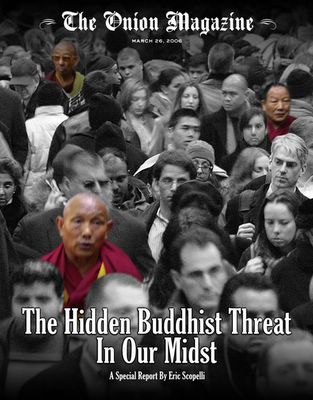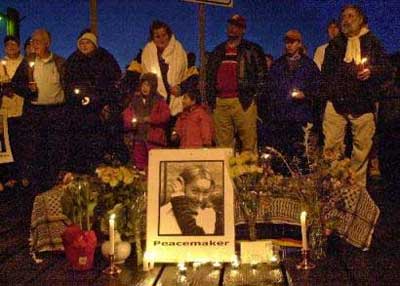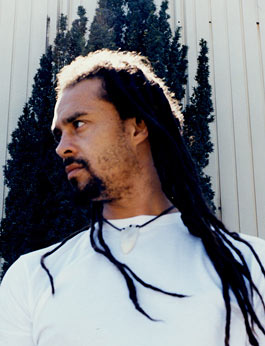 Photo by Steve Appleford
Photo by Steve Appleford
Let it rain: John Brown, 11, helps farmer Lucino Cardozo and his son, Enrique, 11Trouble in the GardenThe 350 families who banded together as the South Central Farmers transformed an industrial dump into a jungle paradise. But now they’re being evicted
~ By DEAN KUIPERS ~ from
Los Angeles City BeatAqui estamos y no nos vamos! (We’re here and we’re not leaving!)–sign hanging on the fence at South Central Farm
Hear the birds? Where else in L.A. do you hear that many birds?” says Tezozomoc – pronounced “tesomoke,” or “teso” for short – an energetic, well-spoken Latino man with an ancient-sounding name. He halts a discussion with a class visiting from the Pacific Oaks School in Pasadena, a “seminar in bicultural development,” to point into the thick, jungle-like foliage behind him.
“We create like this biosphere bubble here, with all of this vegetation,” he adds. “We have 500 trees. We have lizards –”
“Snakes?” asks one of the students, eyes wide open.
“Only politicians,” he laughs. “But what we call our other relations depend on this space, too.”
The space is the South Central Community Farm, a 14-acre community garden just south of downtown smack on Alameda Street, right up alongside the industrial warehouses of the City of Vernon. The contrast with community gardens elsewhere in the city is shocking. These aren’t tiny weekend projects with a few tomatoes and California poppies. The 330 spaces here are large, 20 X 30 feet, many of them doubled- and tripled-up into larger plots, crammed with a tropical density of native Mesoamerican plants – full-grown guava trees, avocados, tamarinds, and palms draped in vines bearing huge pumpkins and chayotes, leaf vegetables, corn, seeds like chipilin grown for spice, and rank upon rank of cactus cut for nopales. The families who work these plots are all chosen to receive one because they are impoverished by USDA standards, and use them to augment their household food supply. These are survival gardens.
The thick chains, padlocks, and security on the entry gates are evidence that these gardens are something more, too. Since Los Angeles developer Ralph Horowitz took control of the property in late 2003, they have become a symbol of resistance. The farmers, who have now been working these plots since 1992, were given eviction notices in 2004 and are suing everyone involved – Horowitz, the city, and original permit-holder the L.A. Regional Food Bank, whose massive building sits next door just across 41st Street – in an effort to turn the block into a new city park that would include continued gardening.
And if that was all it was about, this would just be another squatter land dispute. But the reason teacher Roberto Flores and his students from Pacific Oaks are here, and why activists and academics from Bolivia and Venezuela and Palestine and a land-holding corporation from Colorado and the Italy-based International Alliance of Inhabitants have descended on the place is because it has become a model for community land-use. Its formal decision-making structure, park planning, political outreach, and indefatigable presence at City Hall – they’ve spoken at every City Council meeting this year – have transformed the place into a democracy workshop.
Tezozomoc, one of two elected leaders who represent the farmers to the city, insists that the political and educational battle is now the point. An academic himself, working toward a masters in Linguistics at California State University, Northridge, he addresses the students in their own language.
“In human development, we talk about a heuristic, right? A tool or strategy that leads you toward a solution. If you have tools, then tools lead to new theories. Look what’s happening here. So, giving people this tool – the land – leads to new solutions.”
The gardens, he emphasizes, are a safety net program. First and foremost, they feed needy people.
“But, within the democratic process here, part of the work that we do is to develop people with the ability to be leaders in their communities. We had some people here who have come out and become part of the neighborhood councils, and others who advocate on behalf of people. That is actually what is more important: It’s not only about saving this project, but to develop people with a conscience so that they can stand up for what they believe.”
A Sweet DealFernando Flores, a young architect who is working on future plans for South Central Farm, points out that this food safety net program is an extraordinarily cheap one – the city provides nothing to the farmers and they foot all the bills DIY for water, trash service, security, and farming supplies. In fact, it is expensive for only one guy: Ralph Horowitz.
Horowitz is less than impressed by all the empowerment overlay on the political occupation of the Farm. If the farmers have all been getting a crash political education for the last two years, he has been paying for it. The mortgage on the property is roughly $30,000 a month, he says, plus there’s insurance, property taxes, and the legal costs he’s accrued trying to defend against the farmers’ lawsuit.
“They’ve had the use of it going on 14 years!” Horowitz exclaims. “Even welfare recipients are asked, after so many years, to start to fend for yourself and stop asking your fellow taxpayers to carry you. These particular individuals should be thanking the city of Los Angeles – and suing the city isn’t the way to thank ’em.”
Still, one figures that Horowitz knows what he’s doing. Maybe it’s cost him a million bucks to own the plot at Alameda and 41st for the last two years, but he got a very sweet deal on the property. Even if he decides in the end to sell it back to the city, he might make eight or ten million in profit. And there are some real questions as to why the deal happened that way.
Horowitz owned this same property once before, when the garden’s saga really began, in the late-1980s. These two city blocks – 40th Street runs down the middle of the garden, but has been choked off on either end by fences – were seized by eminent domain to make way for the city’s Lancer Project, a waste-to-energy incinerator that would have generated electricity by burning trash. Horowitz’s Alameda-Barbara Investment Company was the largest of nine co-owners and received $4.7 million in compensation after a lawsuit was settled.
But there was some fine print. Since Horowitz’s company owned about 80 percent of the original property, he claimed he had right of first refusal on the property if the city decided to sell it.
And in fact, that’s exactly what happened. A group called Concerned Citizens of South Central got up in arms about the incinerator plan, and the city backed away from it, letting the property become an ad hoc dump, full of discarded couches and refrigerators. In 1992, after the Rodney King riots brought some City Hall attention to bear (albeit briefly) on what was then called South Central L.A., the L.A. Regional Food Bank approached the city and secured a revocable permit to use the property as a community garden.
“When we first started out trying to get low-income residents to come to the property, we actually had a tough time, because nobody would believe that somebody would let you come and garden for free,” says Darren Hoffman, communications manager at the Food Bank. “But once we got a couple people on there, word spread like wildfire.”
The 14 acres were split into 330 plots, and the Food Bank tested the soil for safety and set up the trash, toilet, and water arrangements that still cost each family only $13 a month. Considering that most plots were worked by a family of four or more, they were directly affecting anywhere from 1,300-to-2,000 people. But the paperwork with the city was explicit: It could pull the plug at any time.
“Originally, we were thinking temporary – we thought this would be like a two-year project. But two years turns into 13-14 years, and nobody sees it as a temporary project anymore,” says Hoffman.
In 1994, the city’s Department of Public Works, which was going to build the incinerator, sold the property to the Harbor Department for over $13 million. That sale was later ruled illegal and reversed.
In 1995, the city began negotiations with Horowitz, who wanted to buy the land back, this time as the Libaw-Horowitz Investment Company. An agreement finally went before the City Council, which refused to adopt the sale. In 2002, Horowitz sued for failure to execute the sale agreement, his second suit with the city over this property.
In August 2003, the City Council finally approved the terms of a sale in a closed session, awarding it to Horowitz for $5.05 million. In essence, selling it back to him for as much as it was worth during the eminent domain process in the late-’80s. Eviction notices were sent out the next month to the farmers working the land.
Since the 1980s, however, big changes would have greatly increased the value of that land. City, state, and federal governments had spent $2 billion building the Alameda Corridor, a modern rail and big-truck super-pipeline from the Port of Los Angeles straight through the warehouses of South L.A. and Vernon. This was now hot property.
“All the goods that are for Wal-Mart are going out to the Southwest from here, from Long Beach and from the L.A. Port,” notes Tezozomoc, pointing at Alameda Street. “About 70 percent of the product that comes into the Long Beach ´´ port is destined for Wal-Mart.”
The land, the farmers argue, was clearly worth a lot more than $5 million. Nine years earlier, the city had paid $13 million just to transfer the land from one department to another, so even using that as lowball number, Horowitz had received an eight-million-dollar break.
And then there was this matter of the right of first refusal. Judge Lawrence W. Crispo ruled several times against Horowitz, saying that a landlord could not negotiate a right of refusal on a condemned property – which is what an eminent domain seizure is, a court condemnation. But the City Attorney’s office, which offered e-mailed responses from attorneys via spokesman Frank Mateljan to questions submitted about this situation, said the “Libaw-Horowitz’ right of refusal was negotiated and became part of the stipulated judgment in condemnation.” City Attorney Rocky Delgadillo urged the City Council to concede and sell the property to Horowitz.
“That just doesn’t hold, though,” says Tezozomoc. “Go back to the original case of Chavez Ravine, right?”
Chavez Ravine was an impoverished Mexican neighborhood of hundreds of households overlooking downtown L.A. that was condemned to make way for low-income housing to be built by Richard Neutra. “If that was the case, if the city changed its mind about building low-income housing there, then they would have had to give the land back to each one of those families, the original owners – which they didn’t,” adds Tezozomoc. “Who did they give it to? The Dodgers.”
Still, the farm deal was sealed in early 2004, and Libaw-Horowitz sent out notices that the gardens would be closed as of February 29, 2004. The Food Bank agreed to begin tearing out the plants and interior fences.
“We were supposed to return the property in the way we received it,” said Hoffman. “So all of the interior fencing would have to go … and, basically, all of the foliage.”
“The Food Bank became our enemy,” says Tezozomoc. “We have gained a lot of enemies.”
Before these notices had even hit the fences, the farmers formed a political committee, South Central Farmers Feeding Families. Elected representatives met with Horowitz.
“Well, I own it, so I’ve been by numerous times just to see what goes on,” Horowitz says. “They called me, and acknowledged that I’d just bought the property, and they asked me if they could stay on it another 60 days rent-free. And I said yes.”
That gave the farmers just enough time to file a lawsuit against Horowitz et al., and get an injunction, allowing them to stay on the property until the suit was resolved. And to buy chains and padlocks.
~ Direct Democracy ~Alberto and Maribel Tlatoa grew up on their plot at South Central Farm. The Tlatoa family has been growing food there for eight years, and now Alberto, 19, has become one of the elected captains of the occupation. He and his sister Maribel, 21, are sleeping on the property at least one night a week, standing guard, while still going to college – a perfect example of the new level of sophistication enlivening the farm community. Most of the farmers are impoverished immigrants, many still speaking the indigenous languages of the Guatemalan highlands or growing treasured 5,000-year-old heirloom corn seeds brought from Puebla, the heartland of Mexican culture. Many of them can’t afford to be involved, politically. But the kids learn to speak English, and learn to make themselves heard. Alberto goes to East Los Angeles College and has been to City Council meetings every week for a year solid.
“They know who I am,” he says softly. Every week he has his name on the list to speak. He’s glad that new City Council President Eric Garcetti has moved the public comment to the start of the weekly meeting, because now he only spends a half-day there instead of getting out late. (City Councilmember Jan Perry, whose district includes the farm, declined to comment for this story, citing the ongoing lawsuit.)
Tezozomoc is proud of Alberto, saying, “He wants to be mayor of L.A. one day.”
Alberto and Maribel turn up to give a tour to the Pacific Oaks class and answer their questions. It’s a day of hard winter sun, and a light breeze flaps a row of 20 flimsy-looking tents that stretch along 40th Street. Alberto is on duty every Monday night, standing around a burn barrel for warmth. “I play the radio real loud at night,” he smiles.
Their duties are now pretty well defined. There’s a General Assembly meeting every week, where all 350 or so families can vote on farm matters like marches or buying a generator. The captains hear concerns and are in charge of security and logistics. Tezozomoc and Rufina Juarez are the elected representatives interacting with lawyers and city officials. And then there is a massive outreach campaign in which everyone does his or her part, bringing in supporters, money, and outside organizing expertise.
“We used to just like work on a little parcel, do our little gardening thing, then just go home,” says Maribel. “We would interact, but mainly just like neighbors. But now, since the whole movement, sometimes we vote and we gather and tell stories.”
She means the farm community, of course, but also the Latino and indigenous Mesoamerican community. “Especially being in South Central, with all the gang violence and everything – we don’t go out much in the community due to that. But now the whole movement has brought the community together.”
Alberto says that Mesoamerican community was one of the reasons why their parents remained committed to the place. The farming was necessary for their family of six to survive, but it quickly took on another function. “Our parents always wanted us to learn these farms were not just about putting something in our mouths, but to learn to grow our culture,” he adds.
Strangely, other demographics are barely represented. There are few blacks, fewer anglos or Asians. Perhaps that represents some kind of accurate picture of who would garden for food these days, but the gardens show a shocking cultural homogeneity.
“This 200 or 300 people wanted to get this property for themselves,” explains Horowitz. “That’s the purpose of their lawsuit.
“It’s not like a park, where you and your wife and your child can go into a park and use any of its facilities, at any time. These farmers are gardening these plots exclusively. As long as they’re standing on there, you can’t use the property. This is not a public function.”
In fact, the park is not even open now, except on Sundays for a farmer’s market. The farmers, it seems, are acutely aware of this perception, and if they can save the gardens as a city park, they are prepared to make big changes. Fernando Flores has already mapped them out.
Flores, 25, was not, like Tezo and the others, someone who grew up on South Central Farm. Last year, he was living in Ontario and going to California State Polytechnic University, Pomona for architecture when one of his mentors there brought him over to see the farm. He saw the potential to give his work a political perspective, and made it his architecture thesis project to redesign the place as a public park.
“You want to check it out? It’s in the back of my truck,” he says, opening the back of a big black SUV.
His model represents about a quarter of the actual land now occupied by the farm, and represents a clear answer to those who say it’s not a public place. A central plaza, surrounded by farm plots, would feature a square of low buildings with a stage area.
“We just finished this this past summer: A hybrid park,” he says. “This is a community center. We have offices, in case we want to have doctors. We have health fairs, here. If you want to have social services, as well.”
“One of the things that is lacking in South Central is, people don’t have access to like a community center where they can have theater or they can have a public event like a concert, right?” says Tezozomoc. The farm already has a stage set up, where bands like Ozomatli and former Rage Against the Machine singer Zach de la Rocha have played, and has a $5 punk show going on the 27th called Disfest. “So it’s a way to help our talent, and our youth, and our community. And that’s really what the basis of this project has been.”
Flores is now co-chair of the Support Committee, networking with community activists outside the farm. “This is the stuff that you read about and watch films about in school,” says Flores, walking through the plots, chatting with people working here and there. “I never imagined this would become my focus. But this is a movement that’s growing out of a seed right now.”
~ Far from over ~Late on a Sunday afternoon, the farmer’s market is just closing up. They don’t sell produce on South Central Farm – although individual farmers might sell you a pumpkin or slice off some cactus for you, if you ask – but Sunday vendors do make hot food to whip up a little cash. There are quesadillas calabasitas (squash), tacos, fried plantains with sweetened cream and shaved cheese, and super-sweet tamarindo and hibiscus drinks. Only a few dozen people mill about, but there’s still time to have a huarache – “like the shoe,” a vendor explains – a folded pastry filled with squash and smothered in sticky nopales, white cheese, beans, and hot chili sauce. A lot of this prepared food comes from outside the gardens, including the chicken or pork; they don’t raise any livestock there.
The place is tranquil, smelling gorgeously of cilantro and hoja santo, a leaf used to wrap tamales which gives off a perfume like licorice when you rub it. If it weren’t for the frequent passage of Metro trains bombing past on their way to Long Beach, you could almost forget these gardens were in the middle of a heavy industrial district.
On June 30, 2005, a state appeals court overturned the Superior Court injunction on the property, giving Horowitz the right to remove the farmers. That was immediately appealed to the California Supreme Court, which refused to hear the case in October. Some elements of the farmers’ case, however, are still alive in the courts. Part of their suit claimed the city violated municipal code by selling the land cheap to Horowitz and partners Jacob Libaw and Timothy Ison. And Judge Helen Bendix had refused to allow the farmers to depose Libaw and Ison – but was recently reversed by a higher court. So, that part of the case moves forward.
“We are going to write another Temporary Restraining Order, because now, we’re saying you cannot destroy this because we need access to these other people, and then we have a good chance to win this,” said Tezozomoc. It’s not clear what information the other partners would have that might swing the case in favor of the farmers. But on the day Tezozomoc was meeting with the class from Pacific Oaks, he said he was “spending the night with the lawyers” to get that next TRO ready to file.
If it’s not already too late. On January 13, Tezozomoc and the captains among the South Central Farmers were gearing up for what they thought might be an imminent raid by L.A. County Sheriff deputies. According to the e-mailed responses from the City Attorney’s Office, Horowitz’s company has sued the L.A. Regional Food Bank for unlawful detainer, since they were the group administering the gardens, and once that’s settled, the eviction might begin. “A judgment is anticipated this week in the unlawful detainer case,” said the Monday e-mail from city attorneys. “That case is between Libaw-Horowitz and the L.A. Regional Food Bank, which administers the garden. The Food Bank is not resisting. A judgment for possession can be enforced using the County Sheriff.”
So the Food Bank, which Tezozomoc considers the farmers’ “enemy,” is all that is standing between them and eviction. The Food Bank’s Darren Hoffman says they’re not sure that, if the city were to take possession of the land again, their permit would still be in place or not. He says they have to wait for the “quagmire” in the courts to be settled.
“From my window here, I can see this beautiful urban garden,” says Hoffman. “We’d be sad to see it go. It would definitely be a loss to the community.”
Horowitz, for his part, says he would consider a buyout offer from the city.
“I wouldn’t agree with their rationale for doing it, but if they wanted to pay fair market value for the property to solve what they foresee is a problem, I wouldn’t stand in the way,” he says.
Meanwhile, the South Central Farmers are appealing to Mayor Antonio Villaraigosa, who has visited the site with his family, and to members of City Council, while they gear up for civil disobedience when and if the eviction comes.
“I’ve been so busy organizing I haven’t had time to eat my own produce,” says Tezozomoc, snatching sweet guavas off a tree planted by his dad. “I just want this place saved so I can get back to farming, get back to school, pay some bills. But this fight’s a long way from over.”
1-26-05






















